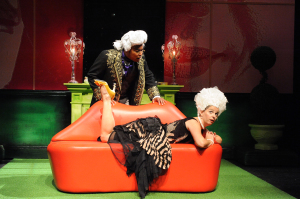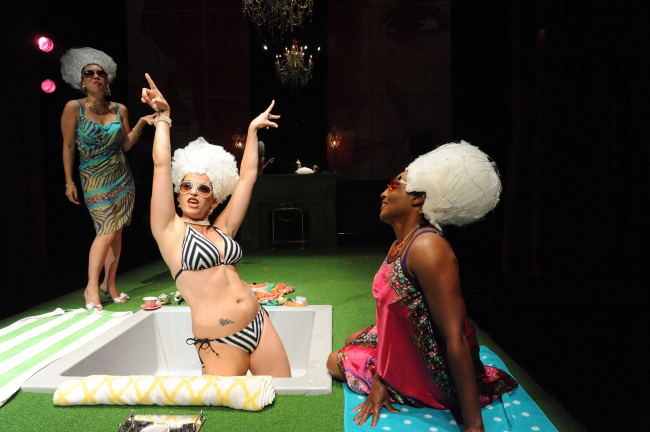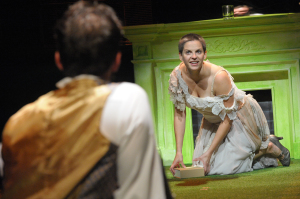Beauty is a function but there is more to life than glittery things. The raw and striking humanity that is viciously exposed beneath the opalescent and lavish lifestyle of the spoiled queen of France kicks off Season 35 at Woolly Mammoth Theatre Company. Marie Antoinette, a revolutionary work written by David Adjmi, is starting off the season with an illustrious bang. Lavish extravagance never looked so good as it does strutting down the stage at Woolly but in the eyes of the masses such expenditures have their price. A provocative new work Directed by Yuri Urnov, draws a social construct around the notion of the people verses the monarchs, celebrity verses nobody, and how at the end of the day we are all little more than the wolf in sheep’s clothing ready to turn a pop culture icon into a pariah at the drop of a head.
Spectacle is prevalent in every facet of the design work, attesting to the nature of history’s conceptions of the title character. Scenic Designer Misha Kachman draws the audiences’ eyes to the grandiose lifestyle of Queen Marie with atrociously vulgar eye-popping pink and shades of chartreuse that border on painful to behold. The brilliance in Kachman’s design is that these revolting grotesque and violently electric shades represent both Marie’s rebellious nature and her unconscious frivolity. Stripping away these elements as the performance carries on, Kachman unveils the true scenic displacement; a parallel to Marie’s removal from the throne. The symbolism woven into the final scenic devices of the guillotine is jarring and deeply reflective.

The costumes are fabulous, toeing the line of fashionable genius in regards to statements of the time flecked with modernity. Costume Designer Helen Huang creates a dizzying fusion of period-inspired costumes with echoes of a time yet to come threaded cleanly throughout. The devolution of Marie’s costumes alone carry the symbolic representation of her demonizing as well as her fall from glory and popularity. Huang crafts a warped elegance into the hair pieces; crown and hair all stacked as one in a twisted and morbid beautiful thing. There is something unspeakably impressive about these hair pieces that fit the production to perfection.
Director Yuri Urnov, working with Lighting Designer Jen Schriever and Sound Designer Eric Shimelonis, create an ingenious thread of modernity that bridges the gap between the historical happenings and modern relativity of the production. The new vogue sounds of modern day Paris a la the fashion district thrum through the entire first act from the opening scene and into the scene changes. This pulsating beat constructed by Shimelonis drives the tempo of the production and draws out a present-day celebrity feel from the atmosphere. Working with that notion, Schriever pinpoints key moments to blast those on the stage— mainly Marie— with a flashbulb of light, accompanied by Shimelonis’ camera shutter sounds creating the notion of the unseen paparazzi. This sensational experience happens throughout, echoing the notions of how modern celebrities and pop culture icons are fiercely scrutinized, misquoted, judged on photos out of context, and applies it with gusto to the historical happenings of Marie.
Urnov’s overall direction of the piece is sound. Playwright David Adjmi has created work that in places reads as stifled; conversation for conversations sake with a fair bit of extrapolated internal monologue being spoken aloud for the sake of being spoken. However, the static nature of the text thrives under Urnov’s direction because he pushes the actors to treat it with a backhanded reverence, particular in the case of Marie. That said, the conversationality of the piece falters in places. Urnov’s vision of binding together the past and present is clear, it is the lack of follow through with the absurdist elements of the show that feels out of place. Urnov could have pushed the moments of the play that are populated with these notions of magical realism and absurdism to more heightened extremes rather than simply dabbling with these devices; a stronger push to the edge of sanity and reality feels warranted but under-delivered.
Louis (Joe Isenberg) is played in a milquetoast fashion. It is unclear whether it is Urnov’s direction with the character or Isenberg’s indecision about taking his emotional extremes to a higher point, but his portrayal hangs suspended somewhere between the childish immaturity and screaming flamboyance that are both struggling for dominance in the performance. To his credit, Isenberg has traces of vulnerability that make his character more sympathetic despite his inaction. Axel (Bradley Foster Smith) suffers from a similar imbalance. His initial appearance on the scene smacks of overly dramatic flamboyance whilst trying to seduce Marie but later his worship of her becomes so internalized that it is maddening. These two actors struggle to find a settled balance for their characters but do both have moments that are refreshingly realistic at precisely the right moments.

Therese (Sue Jin Song) a true friend, and Yolande (Dawn Ursula) serve their functions to Marie’s court. Both Song and Ursula have a regal irreverence about their portrayals, particularly in the opening scene. Both of these women, though experienced briefly, bring a sharpened sense of their own realities to the production— each truly representing the modern elements of the show in their own way. It’s Sarah Marshall as Sheep that turns heads in the supporting cast. Though at first seemingly superfluous, Marshall’s character and its purpose becomes explicitly clear as the production unfolds. Her balance between the absurdity of reality and the reality of the absurd is the epitome of performance. There is an exacting intensity that radiates from Marshall in a way that both fascinates and frightens.
The true voice of reality speaks through the Revolutionary (James Konicek.) Stoic and at times brutal, Konicek represents the truth of the masses. His striking presence upon the stage balances exceptionally well against the celebrity qualities of Marie’s persona. Konicek is inexcusably honest in his portrayal as a Revolutionary; the shocking truth of his line toward the end delivered with unapologetic sincerity beyond compare. Saying perhaps the fewest words in the production, Konicek speaks volumes as a representation of people twisted by propaganda.

Wearing the crown until it detaches from her head is Kimberly Gilbert in the title role of Marie Antoinette. The versatility that Gilbert presents to the audience essentially allows her to carry the bulk of the show upon her shoulders; bearing forth the show’s success in the fluttering bosom of her spastic heart. Crude and rude and out of control at the top of the production, Gilbert is the iconic representation of pop culture; a Kardashian of 18th Century France. But beneath that extravagant irreverence is a deeply fragile child— a shivering vulnerability that is ever so slightly glimpsed upon when Sheep first presents her with a filthy poem circulating in the streets. Gilbert’s descent into madness is harrowing; the finer elements of her ability to transform a character from glorious excess to the ruination of a simple human being are truly astounding. Captivating and ridiculous, Gilbert’s performance is a sensational ride that humanizes the historical figure from both her rebellious diva and simpler child perspectives. A true gem to the stage, Gilbert is stellar in the title role.
The profundity of the show’s ending alone is enough to draw audiences, let your head not make it onto the chopping block for missing this production of Marie Antoinette.
Running Time: Approximately 2 hours with one intermission
Marie Antoinette plays through October 12, 2014 at Woolly Mammoth Theatre Company— 641 D Street NW in Washington, DC. For tickets call the box office at (202) 393-3939 or purchase them online.
Click here to read the exclusive interview with Kimberly Gilbert on playing Marie Antoinette.

